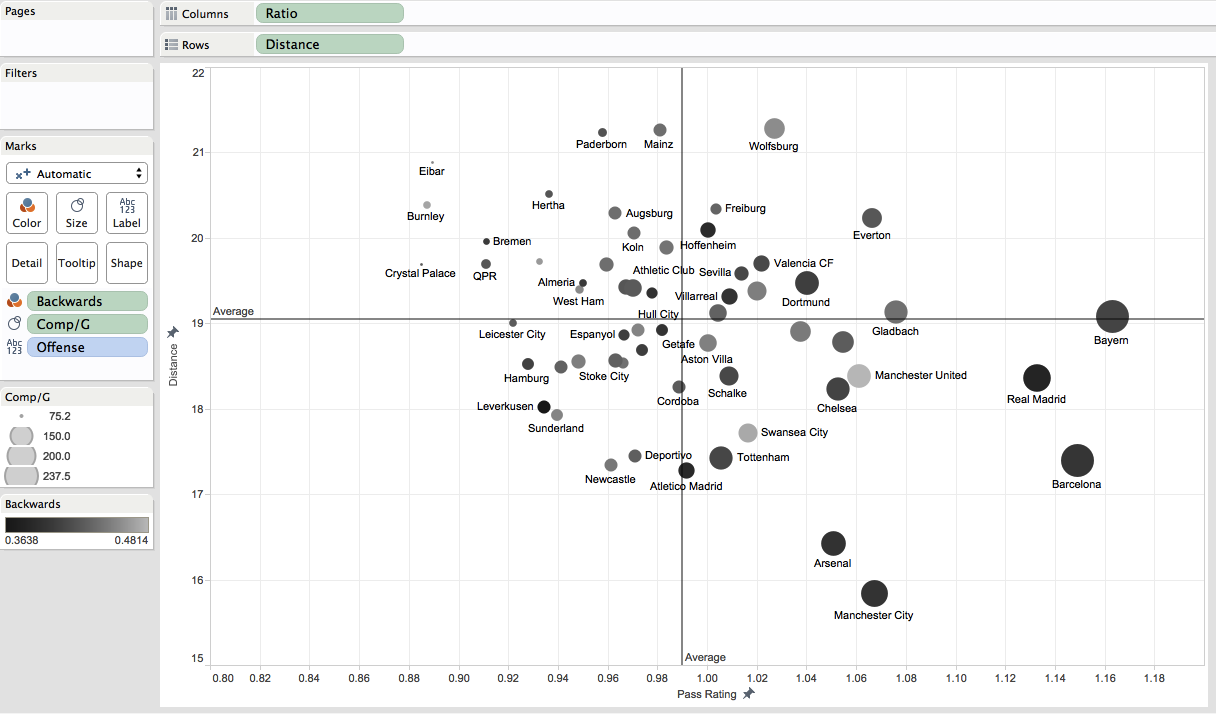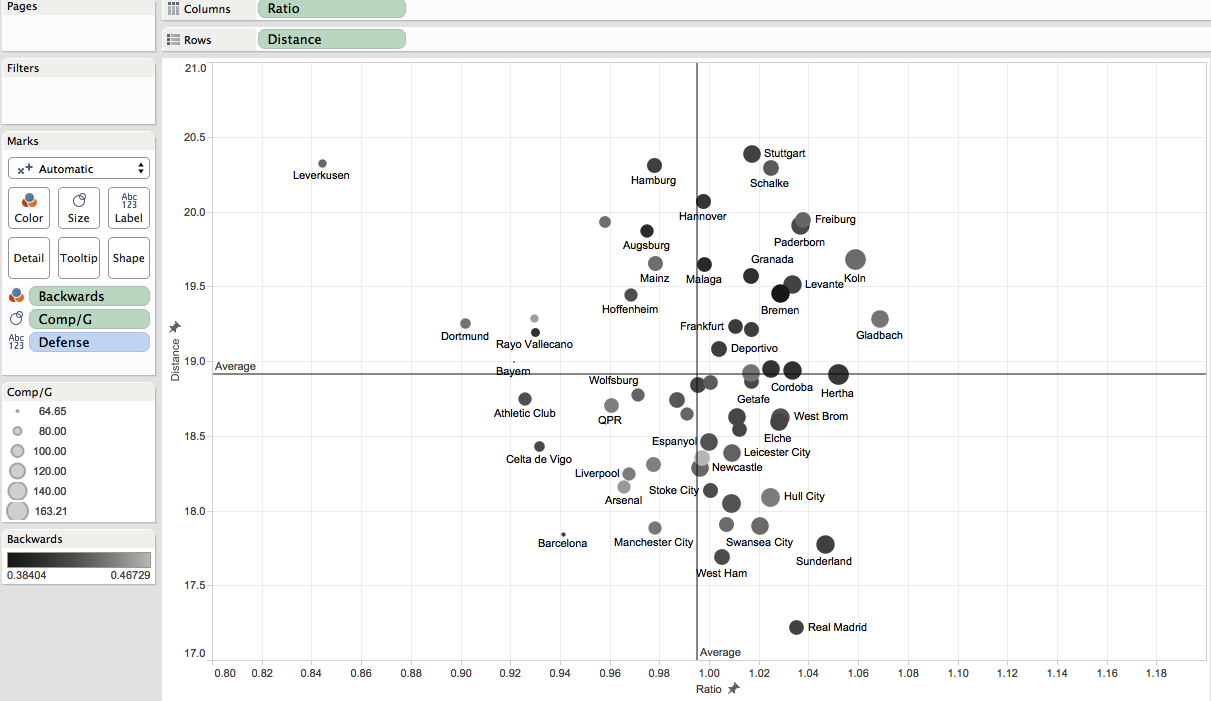Each sport has it’s truisms about where the core of winning teams come from. In baseball it’s “up the middle”, the notion that if you get your defensive players in the middle of the field right, it’s easier to fill the rest. In football, games are won and lost “in the trenches” where the unappreciated lineman clear holes for skill players to score touchdowns. In soccer, it’s the midfield or in one of the more delightful sporting cliches: the engine room. Great forwards will not score goals without a solid midfield to move the ball up and give them plenty of touches. A top class back four can’t hold out for 90 minutes repeatedly if they have to constantly defend against passes coming toward their goal. These are widely accepted truisms but it is pretty hard to look at stats to determine which engine rooms are running at top speed and which are bogged down. Hopefully this is a step toward determining that.
First, we need to define where the midfield is. This is how I defined it, between 38 and 79 yards away from the goal in my advanced soccer graphics representation program. This was just my decision based on what looked right and there are probably other ways of defining it that might be more correct.
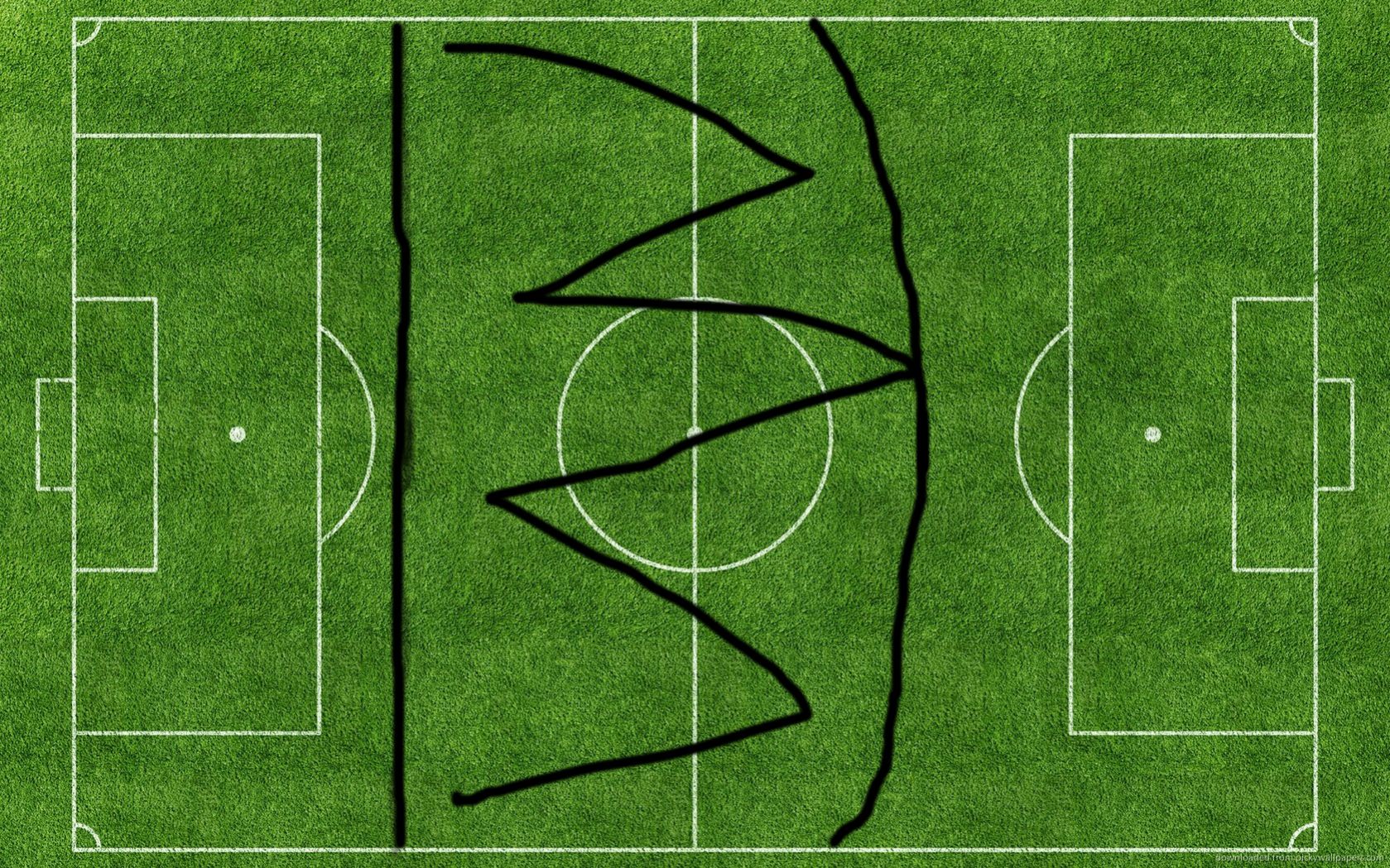
Next we want to determine what stats to use to determine whether a team is dominating the midfield. Number of completions for and against shows possession but we need more, completion percentage is nice but rewards simple, short passes back and forth just inside the area equally with incisive balls through the middle. In the end, I came up with 4 factors to measure a team’s midfield control.
The first three are simple. One: completions per game. Two: the share of passes that are going backwards, mainly for context. Three: how far the average pass travels.
The fourth is a little more complicated. It is basically adjusted completion % on forward passes. To measure which teams were actually best as moving the ball through the midfield, I created a rough model for how an average team passes. It takes into account how far from goal the origin of the pass is and how much closer to goal the ball goes. I did this separately for La Liga, the Bundesliga, and the EPL. For example, in the EPL a pass that originates 63 yards from goal and is targeted at a player 4 yards closer to goal (59 yards from goal)*, is expected to be completed 86% of the time. If a passer is 40 yards from goal and tries to play a ball 26 yards closer to goal (in the box 14 yards from goal) it is expected to be completed 20% of the time. Obviously there are big changes depending on pressure and number of options available: a striker playing a ball forward will have a lower % than a midfielder or a defender simply due to how the team is laid out. This is ok, especially at the team level, as we are simply using this to measure which teams are actually passing well and which teams might be inflating their completion percentage through short passes far from goal. We add up each passes expected completion percentage then compare how many passes were actually completed to see if a team is above or below what you would expect.
*from goal is measured directly from goal. So a pass completed to the corner would be measured as 30+ yards from goal, not 0 even though it might be completed on the end line.
To visualize all of these factors, we go to Tableau and look at the 3 biggest leagues graphed:
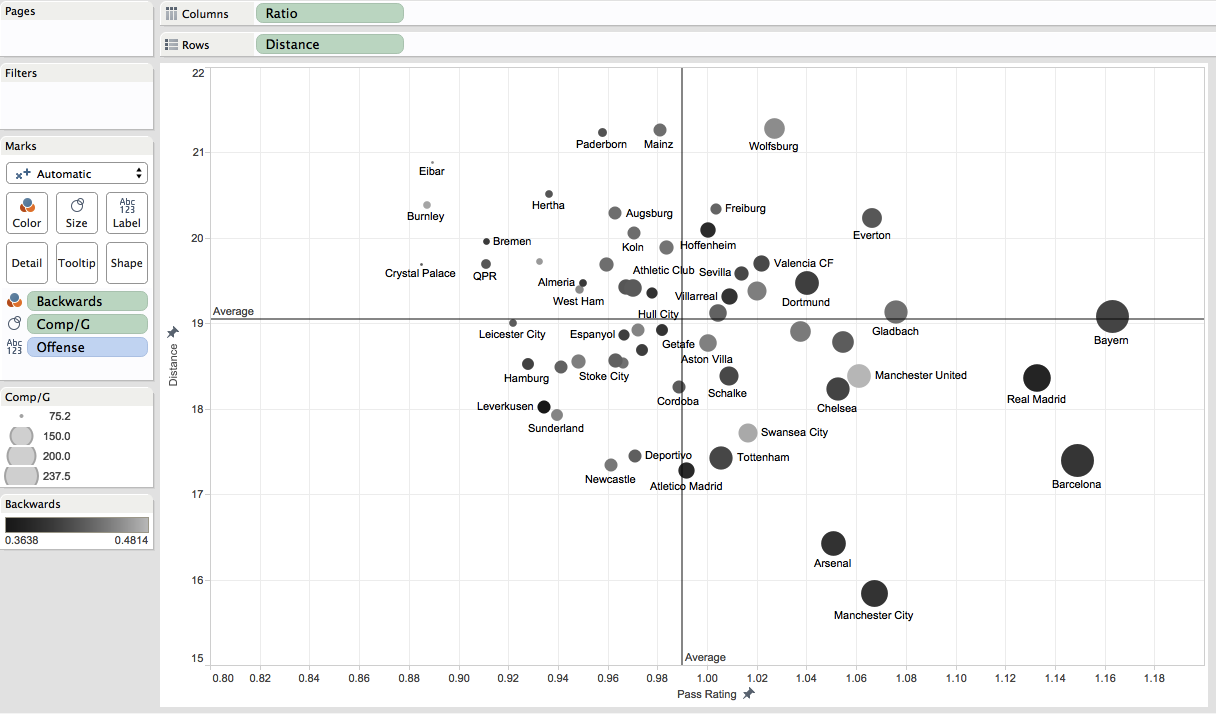
Clickable link for interaction
Far on the left side of the grap we see Crystal Palace, Burnley and Eibar. These are the three teams who completed a lot fewer passes than you’d expect an average team in their leagues to complete. They were only about 89% as likely to complete any given pass as the normal team was. Moving from left to right we see teams like Newcastle, Atletico Madrid, and Mainz around the average line when it comes to pass completion quality. Far on the right, we see the expected big boys in Bayern, Barcelona, and Real Madrid. Gladbach, Everton, and both Manchester teams sit significantly behind those 3 in the second tier of this pass rating.
Looking at the bottom of the graph we see Man City and Arsenal in a group of their own when it comes to playing short passes. Up top we see 3 German teams play the longest passes, with varying rates of success. Paderborn, Mainz and Wolfsburg average midfield pass is over 5 yards longer than Man City.
Looking at the size of the bubbles, we see unsurprisingly that the best teams at completing passes are generally the ones who complete the most. One place we can see a contrast is between Tottenham and Atletico Madrid, who play similar short passes at similar success rates but the difference comes when we see Spurs play complete almost 40 more passes per game in the midfield.
The share of passes that go backwards is the color of the bubble. We see that Swansea and Manchester United are teams in the right half who play backwards passes more than anyone else, in fact Manchester United play the highest share of midfield backwards passes of any team on this chart. This is rare for a top team as you can see, and indicates a lack of forward options, a lack of aggression, or a tactic obsessed with keeping the ball.
Here is the defensive chart with a clickable link for more interaction:
We see two massive outliers immediately. One is Leverkusen, who were just enormously harder to get through the midfield against than anyone else. The other is the infintesimal dot representing Bayern. Teams complete 40 more passes per game in the midfield against Man City than they do vs Bayern. Two interesting teams to contrast are Manchester United and Rayo Vallecano. They see the same amount of passes, are both very good at stopping passes and allow a little above average pass distance. The main difference is teams play forward a ton vs Rayo (because they press extremely high) while opponents play backwards a high amount against United.
Still the single most interesting part of this graph is Real Madrid. Teams play extremely short passes while completing more than you would expect. This was not something I picked up on while watching and something that is hard to explain away as a tactical decision in a league where they are simply so much better than many of their opponents. Something was wrong with Real’s defensive midfield last season, and that looks to be a pretty big hole going forward for a team with UCL and La Liga ambitions.
Chelsea are somewhat close to Madrid, down by Swansea. This is more easily explained as a tactical decision as we know from my previous piece on converting shots to passes that Chelsea are one of the best at keeping teams at arms length or on the edge of the attacking area, and one of the best at keeping passes from being converted into shots.
The longest passes allowed are generally all German teams (see below for more on league differences) and then some bad Spanish teams and then Tottenham, who are right besides Augsburg. Only Man United and strangely QPR are better at stopping passes through the midfield than Tottenham, the main problem with their defense was the passes that get through are long and dangerous, and are converted into shots at a higher rate than any other EPL team. This would suggest at first glance that the backline is more of a problem than the midfield. United had similar problems, though they were tougher to pass against and not near as susceptible to passes being converted to shots.
Combining shot conversion and midfield control
We saw how Chelsea’s unimpressive defensive midfield numbers were overcome by the sterling job they do stopping deep passes from being turned into shots, let’s see if there are other interesting separations.
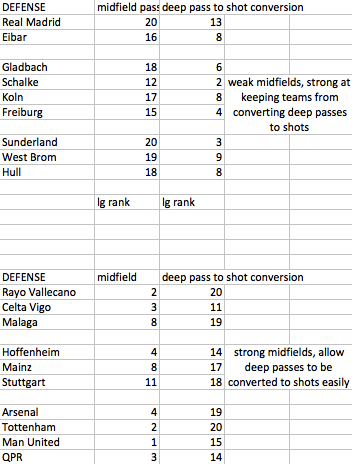
There are obvious tactical reasons for some of these (Gladbach’s shelling, Celta/Rayo’s high presses) but there are some general conclusions we can make. If my team was in the second group, I would look first to upgrade my back-line if I wanted to improve my defense.
Combining offense and defense for total control of the midfield
To see which teams really control the midfield as the title mentioned we will combine the offensive and defensive metrics. The ratio of completions/completions allowed and the amount pass ratings on offense and defense are combined for one ranking.
Top 10
1. Bayern Munich
2. Barcelona
3. Dortmund
4. Manchester United
5. Real Madrid
6. Manchester City
7. Celta Vigo
8. Arsenal
9. Liverpool
10. Tottenham
Real Madrid’s poor defensive showing is outweighed by its dominant offense. The rankings give some weight to the idea that a good midfield will build you a good team. One interesting team not in the top 10 is Chelsea, who were 15th overall but still won the league without a dominant midfield.
Looking at individual teams


When you see a team rank high or low, the next question becomes why are they so high? What players are dominating the midfield for them? While this is still a very hard question that I am in no way certain of answering, looking deeper at this kind of passing data can help tell us a little bit. We will look quickly at Man City and Liverpool, two teams who were both easily above average in number of passes and pass rating (completed passes compared to "expected" completions).
We won’t look at defenders (though I will mention Mamadou Sakho was nearly off the charts in how well he advanced the ball aggressively) or forwards (where the differences between Eden Dzeko, Stevan Jovetic and Aguero are very noticeable) but will focus only on midfielders for now.

The midfield pass rate is basically how well the player is doing at completing passes that move their team toward goal in the midfield. A rating of 1 means they do exactly as well as an average EPL player, as you can see everyone here has a rating above 1, except for Milner who is 6 points below the average EPL player when it comes to completing these passes. His role was obviously much different at City than it will be at Liverpool, but the number remains a big worry for Liverpool fans. He is now being featured in an area where he really struggled to move the ball last season. When you factor in every pass over the whole field (overall pass rate), we can see Milner rises above average indicating he was at his best in the final third. His volume of work will drop there and rise in the center of the pitch in the upcoming season. Of course, more than half of the game is missing here but defensive work will come in another time, another article.
Other interesting player notes: Jordan Ibe’s high rating in limited minutes bodes well for his future and it’s another reminder of how silly good Yaya Toure and David Silva are. Liverpool as a whole saw their pass ratings drop the further upfield they got, no surprise to Liverpool fans who watched as they played an extremely conservative style for most of 2015, committing very few players forward. The limited attacking options made it very hard to pass, which will make it interesting to check in on Sterling at Man City and Coutinho with more options to see if they raise their ratings.
This is a broad overview of midfields, there are probably 20 articles to be written simply on Liverpool alone and there are tons of ways of looking deeper (who is forcing teams to play through the edges, hint: Villarreal, looking at game-by-game throughout the season and wondering why Liverpool had such poor midfield numbers vs Tottenham and great vs Chelsea while awful at home vs City and great away, etc) but hopefully you enjoyed this start. Any questions, comments, criticisms, etc feel free to reach me on twitter @Saturdayoncouch or post in the relatively new comment box below and I will be glad to discuss. Spammers, if you have read this far I am all set on sunglasses so please do not post.
Postscript comparing leagues
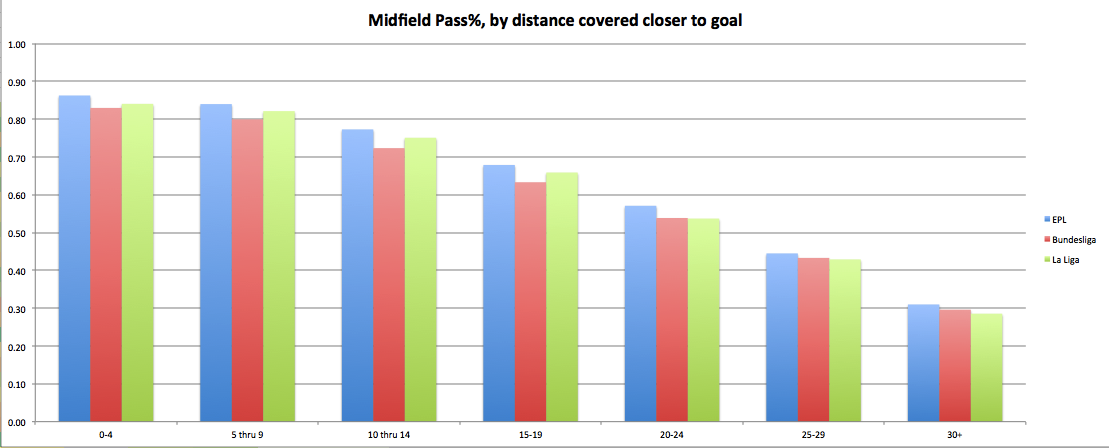
I promised a breakdown between leagues, but ran out of time. Here is a quick graph comparing completion percentages for different length passes. The Bundesliga is noticeably harder to complete passes. La Liga tends to see more short passes and Bundesliga: more long passes. Another time, maybe we can expand but there’s never enough time, right?
